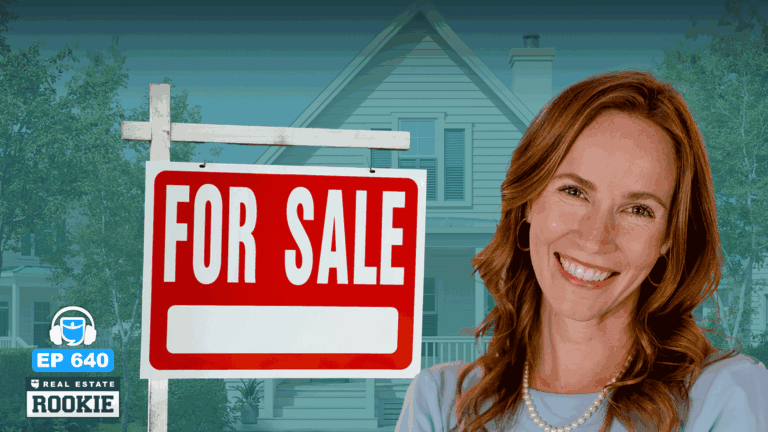Dave:
2025 is winding down and so much has changed, but somewhat frustratingly, some things have not changed at all. I’m Dave Meyer, and today I am joined by Brian Burke to wrap up the year, cut through the headlines and talk about opportunities that are going to exist for investors going into 2026. We’ll touch on where the opportunities have opened up, what risks are getting bigger and how to avoid them. And generally just how to position your portfolio for the next 12 months. This is on the market. Let’s get into it. Brian Burke, welcome back to On the Market. Thanks again for letting us drag you back here,
Brian:
Dave. It’s always fun to be here. We always have a fun conversation.
Dave:
I agree. It is always a good time having you here, so thanks for helping us close out the year here. That’s kind of where I want to start is maybe just looking back at 2025, how would you describe or characterize this past year?
Brian:
Well, I would call it a bit of a year of some turmoil and chaos I suppose, and chaos breeds opportunity and the more of the former you have more the latter you get. So I think it’s been a year that’s going to set people up for some really good things down the line, but for some it’s been a bit uncomfortable as any tumultuous year would be. So it certainly has been interesting to
Dave:
Watch. Would you describe that for both residential and commercial markets or one more than the other?
Brian:
I think it’s actually applicable to both. I think residential markets at the beginning of the year, I expected that they would do better than they have. I mean, of course it’s all regional, right? But what I’ve seen kind of on a macro level has been a little bit of a slow residential market or slower than I would’ve expected, and commercial was almost non-existent for the first half of the year. It’s starting to pick up a little bit in the second half, but I think that might even be misguided a little bit.
Dave:
And do you attribute that to rates, at least for the residential side? Do you think it’s still just the financing climate?
Brian:
I think that’s part of it. I think there’s an inventory problem in some areas. I know, especially where I live here in Northern California, we have an inventory problem. There’s too many houses on the market for buyers that are in the market. And partly I think that’s because of two things. One is you don’t have a lot of move up buyers because anybody who owns a house with a 3% mortgage isn’t selling. That means they’re also not buying something else. So I think that’s part of it. And then first time home buyers are struggling with large down payments and higher interest rates and just overall difficulty in buying. So I think that’s slowed down. Buyer traffic for 2025,
Dave:
Was there any bright spots you saw or was it just all ugly in 2025?
Brian:
Well, the only bright spot I found was in senior housing and we made a pivot to senior housing assisted living, skilled nursing and memory care earlier this year. And that’s been a total bright spot. But outside of that data centers I hear is a really good spot to be, but I think it’s dominated by the major players in the industry. It’s not really an individual investor play, but outside of those two specialties, I haven’t seen a lot of extraordinary opportunity or anything to get all that excited about in any real estate sector this year.
Dave:
Well, we appreciate you keeping it real. That’s why you’re here. We don’t want any fluff. If it was an ugly year in 2025, I actually maybe in the last two months have noticed better deal flow. I feel like the numbers when I analyze a deal are looking a little bit better on the residential side, not fully great across the board yet. Have you noticed any of that though, or are you just sticking to There’s no silver lining at all. Everything’s miserable.
Brian:
Well, that’s been a good theme for me for the last two or three years. If you recall my past appearances on this show.
Dave:
Yes, we know what we’re getting with you.
Brian:
Yeah, you do you know what you’re getting? Is there a silver lining? Well, I’m starting to see some threads of a silver lining. Interest rates have fallen a few tenths of a percent, not anything major, but I think that might be helping a little bit. I think pricing is starting to ease in some places because some sellers are just having to come to grips with reality that the property, whether it’s a house or whatever it is, isn’t worth what they thought it was or isn’t worth what it may have even been a few years ago. And so they’re having to get real with, okay, if we’re going to move on, we got to meet the market. And I think some sellers are meeting the market and some buyers are having the ability to step up, and that’s creating a little bit of a silver lining over the last few weeks. But I don’t see a major title shift just yet.
Dave:
No, it’s frustrating, especially in commercial. I think you’re much more of an expert in commercial than I am, but I’ve keep waiting for this distress to come to a head and it feels like it just doesn’t. I know it’s trickling and prices are down, but we’re not seeing what I would think the inventory levels or the transaction volume that I would’ve expected a year or two ago given how stressed how much stress there is in the multifamily market, for example.
Brian:
Yeah, well at first that may seem unusual, but when you really start to dig into the details of why that’s happening, I think it makes complete sense. So prices have fallen dramatically in the multifamily side and worse perhaps than even the 2008 great recession from peak to trough. So if you’re a lender in that space and you started out with a call it 80% LTV loan that also supplied a hundred percent of capital improvement financing, you’re dramatically upside down as a lender. I mean, forget about the owner and how upside down they are. The lenders themselves are upside down. So they’ve been so-called kicking the can down the road and saying like, Hey, I know your loan is due, but we’re just going to forget about that for now and give you another year. And the owners are like, great. We got to stave off foreclosure for a year.
Dave:
We’ll take it.
Brian:
You guys are wonderful. Thanks for taking care of us. Forgetting completely about the fact that really what the lender’s doing is protecting their own balance sheet, right?
Dave:
Oh, you mean the banks aren’t just doing it out of the kindness of their hearts?
Brian:
Oh, of course they are. They always operate that way
Dave:
If you can. That’s how banks
Brian:
Work. Yeah, provide me an example of that. I would love to see it. But the banks are waiting for better markets to sell into and really they’re the ones that are in control. I mean, the owners who think they’re in control aren’t really the ones in control when there’s a loan maturity that’s in play. So the lenders will at some point say, enough is enough. We’re not giving you another extension you need to sell. Now, even if that’s at a complete loss to you and a small loss to us, that’s when the distress is going to hit the market. But it’s going to be when prices actually come up a little bit because the lenders don’t want to sell at the bottom either. So that’s why you’re not seeing this big so-called wave. And that’s also why I think, and this is just my opinion, it may be wrong, but we’ll see that the wave is going to be a long slow wave that you could ride for a really long time, not one that’s going to last 20 seconds and it’s over. This is going to be a bit of a recovery process that’s going to take a period of years, not a period of weeks or months.
Dave:
And when you’re saying that wave, obviously that’s challenging for existing operators, but does that mean the buying window will be longer for people who want to get into the market?
Brian:
Yes, that’s my point. Exactly. And that’s also why I haven’t bought a multifamily asset in what, three and a half years now. I guess because there’s been no reason to and there’s still no reason to, and I’m still not buying. And once the market starts to improve, then maybe I might start buying, but I know that I’ve got plenty of time. I don’t have to be in a rush to say, I have to exactly time this bottom because I’m going to miss it and it’s going to run out without me. That’s not the risk. The bigger risk in my opinion, is that you get into early and you have to sit through this long level period of this, the bottom of the trough for a long time before the value starts to creep up, and your time value of money erodes your returns. I think that’s the bigger risk.
Dave:
I think you’re talking specifically about multifamily right now,
Brian:
Right? Yeah, large multifamily. Now, we had a conversation on your other show recently about small multifamily and as a wealth building tool for individual investors that are casually buying properties. Occasionally, I think there’s a real opportunity for life transforming wealth over the long term, but for those who are buying commercial, multifamily, larger assets, especially those who are doing so with capital, they raise from other investors would find this to be a very tough period to produce the type of outcomes that their investors would be happy with.
Dave:
The difference being if you’re not trying to satisfy LPs and other people who are raising money, the risk of getting into early is less. Is that kind of the theory there?
Brian:
The theory is is that if you’re a casual investor who might buy one or two properties a year, this might give you the opportunity to buy five or six properties because you can only buy a few properties a year. For professional investors at commercial real estate who I’ve bought 19 properties this year so far in the senior housing space now, if I did that in multifamily and had 19 assets, that’s a lot of real estate that’s going to sit there languishing in value for a long period of time with a lot of investor capital that just wouldn’t really have that great of an outcome. It’s just two completely different investing strategies. And one thing about investing in real estate, there’s not one strategy. There’s different strategies and different strategies require different tactics.
Dave:
We got to take a quick break, but we’ll have more with Brian Burke right after this. Stay with us. Welcome back to On the Market. I’m Dave Byer here with Brian Burke. Let’s jump back in. Well, you’ve been talking about it all year that you still think the buying of small multifamily makes sense. And are you seeing prices go down for those as well?
Brian:
Yeah, pricing is easing, especially when you look at peak, peak to trough pricing and peak being, I would say second quarter of 2022 was what I’d consider to be the peak of the multifamily market space. And if you look at pricing today relative to that small window, it’s definitely cheaper to get in now than it would’ve been to get in then and a lot less risky.
Dave:
The only thing that discourages me a little bit, not in the two to four unit, but in that four to 20 unit, is rent growth just seems really slow right now in most markets. Is that something you are thinking about and seeing and does that offset some of the opportunity in the mid-size multifamily space, that five to 25 unit range?
Brian:
Yeah, it does. If you’re momentum playing, if you’re arbitrage playing, then maybe not so much. And again, every strategy requires different tactics. So if your strategy is to buy deeply discounted, heavily distressed, multifamily, even in a mid-size, you can go in and extensively renovate and improve and boost rents and improve the income, then you’ll be fine. The rent growth isn’t this big of a deal as your entry basis is made with the rent growth prospects in mind and you’re not thinking like, okay, well I’m going to pay this price because I think I’m going to get 10% rent growth. If you’re not doing that, then you’ll be fine. So I don’t see that as quite that big of a risk. But if you’re a momentum player where you’re buying stuff basically turnkey, maybe a class B plus class, a newer mid-size multifamily with the intent of just riding the wave of multifamily rent growth, you might be disappointed in that strategy or you really are looking at it as a generational wealth play and not as an immediate return play, in which case it may work out fine, but as an immediate return play, I think it would be difficult.
Dave:
Yeah, last year when I was trying to figure out what I was going to do talking about on the show, I was hoping that right now in this point in 2025, we’d start to see the tide turning on rent growth a little bit just because we’d be working our way through the multifamily supply glu. But unfortunately I just don’t see that happening in 2026. I just think we’re still at least a year away from, like you said, the momentum play. That doesn’t mean you can’t do value add and drive up your rents, but if you’re just hoping for the macroeconomic forces to drive up rents, I think it’s going to be another slow year for that in 2026.
Brian:
You’re right, and the statistics bear that out. So in October of 2025, we saw the largest rent decline of any October over the last 15 years on a national
Dave:
Level.
Brian:
So there has actually been rent declines and a lack of rent growth. And that certainly is a factor. And I think when I’m looking at a sector of real estate to invest in, the momentum does have a lot to do with the decision. And there’s a lot of things that are working against multifamily right now, such things as low birth rates. Renters remember is the younger demographic. So you’ve got low birth rates, you’ve got low immigration, and you have high construction. And to your point a minute ago about construction levels have remained unexpectedly elevated. Everybody thought be 2025, it’s all going to taper off, the building is going to be done, but yet it still keeps coming and that’s fighting against these other factors of low birth rates and low immigration and all of that stuff is just creating lackluster rent growth for the time
Dave:
Being.
Brian:
Now that won’t continue forever. The tide will shift and it’s always darkest before the dawn, so we will see what happens.
Dave:
The construction thing sort of confounds me. I started my investing career in Denver, still own property there, and it’s getting hit pretty hard right now, even in the single family and residential space, prices are down, rents are down, and it’s one of these classic overbuilt cities. If you look at all of the data, you just see that there’s been way too many deliveries. Absorption is low. And then I was reading something that was like new construction, multifamily starts in Denver, second highest in the country. I’m like, what the hell are people doing? Why are they doing this? And I guess they’re just expecting three years when these things are completed that will have worked through this backlog. But man, it is a little confusing why this is still going on.
Brian:
Well, I think there’s two reasons at play. One is that construction and development takes an extraordinarily long time, and so from concept to shovels to vertical construction, you’re talking about periods of years, not days, weeks or
Dave:
Months.
Brian:
And so a lot of these projects were past the point of no return and are just now finally getting to fruition and they can’t really put the brakes on without losing tons of money. So they’re like, well, we’ll just hope for the best and maybe our timing will work out so the projects keep going. That’s one reason. And another reason is you still have some developers who are like, Hey, the construction glut is going to wane in 2025, so by the time we’re done, the timing’s going to be perfect, so then there’s too many people thinking that way and you end up with too much product still. And so I think we’re stuck with both of those things happening at the same time.
Dave:
Do you think any of that will spill over into the residential space either in terms of rent growth or demand for housing? Because if rent is relatively cheaper than buying a home like it is in the vast majority of places in the US right now, do you think that’s going to sort of hamper or weigh on the residential market?
Brian:
I don’t know. I’ve got a lot of class A apartments in Atlanta, still about a thousand units, and there are two reasons that we experience move outs. One reason is that people have financial difficulties and have to downscale whether they’re moving back in with family or whatever, but the other largest reason is they’re buying a home. And so surprisingly, it still seems like the American dream of home ownership is still alive and well, it may have needed supplemental oxygen for a while, but I think the patient’s going to survive.
Dave:
It’s still a priority for people. The desire for home ownership certainly hasn’t changed, even if the affordability and the challenge of actually accomplishing it has changed a lot of it in the last couple of years.
Brian:
It has. And I think anybody listening to this show especially would on a personal level, relate to wanting to own your own home and somewhat having control of your own destiny and maybe the prospect of someday owning it free and clear and not having a payment to provide you with long-term financial security into your later years. I mean, I think a lot of people listening to this show would understand that.
Dave:
So does that mean you’re not a fan of the 50 year mortgage?
Brian:
Well, it’s interesting. I see some benefit to the 50 year mortgage as it opening the door for people to an extent, but the challenge is it has to be used responsibly. If you could get in with a 50 year mortgage because you can’t afford the payment, but as your income increases, you consistently increase how much you’re paying on your loan and then you end up paying it off in say 20, 25 years, it could be a remarkable tool for someone that’s responsible and disciplined enough to do that.
Dave:
Totally.
Brian:
I think there’s a segment of the population that maybe doesn’t possess that level of discipline, and in that event they’ll be paying interest for 50 years and maybe they benefited from it and maybe they didn’t. It’s hard for me to say,
Dave:
Yeah, I know. I think as an investor it’s just not worth it. I did the math, I did an episode on it for an average price home, it just saves you 200 bucks a month. It’s not that significant. A savings and the amount of interest you pay over time is enormous. So if your dream is to own your home free and clear, it just makes it so much harder. But I do agree that there are some use cases. I would just worry that I think this already happens. This happens in car sales, it happens in home sales that people focus really on their monthly payment and not what they’re paying in total for an asset or for anything. And I would just hope people aren’t making that decision uninformed if this even comes to bear. We don’t even know if it’s going to be a thing at all.
Brian:
Well, I mean if I look at my own personal situation, when I bought my very first house to live in 35 years ago, $200 a month would’ve been a big deal to me, and that would’ve really helped me get in. But if I look at my income now, that payment would be a rounding error. It would be nearly nothing. So if I continued to increase how much I was paying in connection with how much I was making, I would’ve paid that loan off far sooner than 50 years, but it would’ve been really useful to me in years one through five,
Dave:
But
Brian:
It really just depends on how you use it, and I think a lot of people use debt very responsibly, but there are people who use debt irresponsibly and would use it to just buy more than they can really afford, and they’ll end up paying interest for 50 years because they won’t increase their principal pay down as their income grows. They’ll just buy more boats and things like that.
Dave:
When we return more insights on the year end playbook, we’ll be right back. Thanks for taking with us. Let’s continue the conversation with Brian Berg. Let’s shift focus a little bit. I want to talk about 2026, and I know you were just negative about 2025, but I want to hear how negative or if you see if there’s opportunities in 2026. So I’m going to tell you the name of an asset class or a strategy, a niche in real estate, and why don’t you give it a score A to F with high school grades here, 4, 20 26, single family rentals,
Brian:
B minus,
Dave:
B minus. Okay. What about small multifamily,
Brian:
B plus
Dave:
Large multifamily
Brian:
C?
Dave:
That’s not as bad as I thought you were going to say. Maybe a C minus. C minus. Okay. Well, I know you like senior living, so what do you score Senior living
Brian:
A
Dave:
A? I like that. Okay, let’s go to some of the other niches. What about self-storage? Do you know anything about it?
Brian:
Yeah, I used to own a self storage facility. I’d give it a B.
Dave:
Okay. Not bad. All right, and what about build to rent?
Brian:
Oh, that’s getting flooded. C plus to B minus probably C plus.
Dave:
I don’t know if you want to invest in things you’re grading a C in a given year, but yeah, I mean is B plus good enough for you like a small multifamily, it sounds like?
Brian:
I think that it depends upon your strategy and if your strategy is a fit, I think this is a good time to do small multifamily for a long-term generational wealth building strategy for the casual investor. Absolutely. If you’re going to tell me that you’re going to start a hundred million dollars fund to go buy thousands of duplexes, I would think that that might not work as well.
Dave:
Well, that’s a good point. So let’s talk a little bit about strategy. What is the right strategy? What is the kind of deals that you should be looking for if you want to go after those small multifamilies next year?
Brian:
I think you’re looking for the tired landlord that just wants to exit maybe long-term owner that just has to get out, or maybe a newer term owner that’s in foreclosure or distress properties where you can make some improvements to the asset to improve its income and rents and something that you would be comfortable holding for 20 to 30 years and just using it as a generational wealth tool. For those folks who are trying to build a portfolio like that for a secure retirement, this is a great time to start building something like that because building a portfolio like that for generational wealth, especially for smaller casual investors who don’t have this huge bucket of investible assets, takes a lot of time. And I think that’s what you have right now is this wide window to be able to accumulate this portfolio at really attractive prices not to be like, I have to time the bottom exactly, and we’re going to buy a hundred fourplexes all within a three month window because that’s the bottom, and that’s when you got to get in because if you do own it for 30 years, you’ll have long forgotten 30 years later when you bought those things and what you paid for ’em. It’s not going to matter
Dave:
A hundred percent. That’s honestly how I’ve been thinking about growing myself. I was like, I think we’re going to be in a pretty stagnant market for a couple years, and I know that scares some people. If you’re a flipper, that might be a little bit difficult, but I think for me, I’m like, I just get to sit back and be more patient than I’ve been able to for several years because I’m buying for 10 to 15 years from now. I’m going to just look for small multifamily, put on a 15 year note and be patient, and I care what I buy it for, but I actually think right now I’m going to be able to get better prices. And I think the sacrifice is the cashflow and the rent growth might not be amazing in year one, but I don’t need it to be amazing in year one. I care more right now about getting a great asset at a great price, and then I just need it to perform in 10 years, which is I have a high confidence that it will.
Brian:
Well, those who follow your roadmap that you just outlined are going to have life-changing transformational wealth that will happen over a period of years and decades. Contrast that to somebody who followed that roadmap and let’s say 2021 and began accumulating a portfolio like that 20 21, 20 22, and then it immediately falls off the cliff.
It doesn’t mean that, oh, the whole thing’s never going to work out. It just means it’s going to take a long time to get back to zero. But if you keep doing it and you do it through this period, it’s going to provide extraordinary opportunity for you later on in life, and this is a really great time to do it. This reminds me a lot of the early 1990s, from about 1991 or 92 to about 1997, prices didn’t move at all. I mean, they just stayed completely flat. And there was this long period of time where you had to accumulate assets, and if you did that, boy, by 2003, you were making a killing and granted it went up to oh five and then it fell down in oh eight. But by 2013 it was right back to where it was before and even
Dave:
Higher. And I think even in oh 6, 0 7 when things started to fall apart, they didn’t go back to 90, 97 levels, did they?
Brian:
Some of ’em did. Yeah.
Dave:
In fact,
Brian:
I bought some properties in 2009 and 10 that I looked up their transaction history and they last sold for prices I paid in the 1980s.
Dave:
Oh, that’s not great.
Brian:
That’s, it’s not good.
Dave:
It’s not what you want.
Brian:
It’s not what you want. But if you hold a dividend stock and the price fluctuates, but you’re collecting your dividend, you don’t really care if you’re going to own that dividend stock for 50 years,
Dave:
Hundred percent.
Brian:
If you bought it at the very top, it’s going to be a lot more painful than if you kind of bought it at the bottom, rode to the top, wrote it back down and then wrote it up again. That’s a much different story because you don’t have to get a big increase just to get back to zero, right? So I think that’s what makes a difference. And accumulating now means that if prices go up and then later they go back down, you’re still above zero and this is a much better time to invest than if you did it in 2021 where they went down and now you’re below zero and you got to wait to get back to zero.
Dave:
What do you think about the best debt structures right now? What’s holding people back a lot is, I think it’s just high mortgage rates. Curious where you think things might be heading. We won’t hold you to it, but if you had to guess today, where do you think rates might go next year?
Brian:
I think long-term rates are going to remain relatively flat for a while. I don’t really see major movement one direction or the other, maybe a half a percent one way or the other. And I couldn’t even say which direction that half a percent is going to be. Short-term rates I think are bound to come down, so I think we’ll see a little bit of an easing in especially the SFR, the secured overnight financing rate. I think we’re going to see that come down a little bit as the Fed continues to ease really in the residential space is driven by the 10 year US treasury bond because that’s what drives pricing on 30 year fixed rate financing. And I think as far as any financing package goes, there’s no better financing package than the fixed rate fully amortized 30 year residential mortgage loan.
There’s nothing else better than that in all of real estate investing in any sector, it’s a fantastic vehicle because if rates go down, you can pay it off and refinance with a lower rate loan, and if rates go up, you’re protected and you’ve got 30 years to pay it off. And if the 50 year loan thing does pass, it’s kind of the same thing except longer and more interest, but depends on your level of responsibility. In the commercial space, you don’t have that luxury. You have to choose between one risk or the other interest rate risk or yield maintenance risk or prepayment penalty risk. So that’s a whole different
Dave:
Discussion. Yeah, yeah. Well, I’m glad you said that. I was wondering because you’re saying, and I agree with you that short-term rates are going to go down. I mean, I think that seems pretty clear that there’ll be some downward pressure there. I agree. Long-term rates less likely to move. It might become appealing for people to look at arms again because the spread might get bigger, but I personally think there’s as good of a chance that in five or 10 years rates are higher than they are today, than they are lower. And I just don’t want to take that risk. And so I like the way that you said it, that you still have the option to refinance, but you are protected against that downside risk. And I just still recommend to people, even though you’ll pay a little bit higher interest rate right now, the ability to control your downside risk is so incredibly valuable when you’re pursuing the strategy that Brian and I have been talking about, accumulating wealth for the long, long-term, knowing what you’re going to pay every month and not having any risk to that is kind of essential in my mind to taking this long-term approach because otherwise you’re exposing yourself to risk five to seven years down the line.
That’s just not necessary to take. If you’re a residential investor,
Brian:
There’s only one downside to the fixed rate mortgage, and that’s that it might cost you a few more basis points in interest rate than an arm. That’s the only downside. But you can completely that downside at the onset, so you know what you’re getting yourself into, what the cost is for that peace of mind, and it’s a peace of mind insurance premium. And believe me, you would pay that for fire insurance on your house for the peace of mind of knowing that if it burned to the ground, you could have it rebuilt. So this is the same thing. The difference between the arm interest and the fixed rate interest is your insurance premium for the peace of mind of knowing that your mortgage may never burn to the ground, but if it did, you’re totally covered. Interest rates could go to a hundred and you’re still fixed.
And there’s zero other downside because if rates drop, you can easily refinance. That’s what’s different about commercial. Commercial, if you want to go fixed rate in commercial, there are other downsides beyond what you can immediately quantify and prepayment penalties and yield maintenance and those kinds of things that make you choose which risk you want to have. But in the residential space, residential one to four, and in some small balance multifamily, you can buy a 10 or 15 unit on a fixed rate mortgage, fully amortizing from local banks. When you can get that kind of a financing package, there is very little downside and you would almost be self-inflicted wound to yourself to not do
Dave:
It. All right. Well, Brian, as usual, this has been super helpful. Thank you. Is there anything else you think the audience should be thinking about as we head into 2026?
Brian:
Well, I think you should be thinking about building that portfolio as we’ve been discussing here today. And if you’re a passive investor in syndications of larger commercial assets, I think that you can be patient and you can wait for the right opportunities because there’s no need to jump in too soon too fast or go all in because you’re not going to miss the runup in the market. It’s going to take time for that to materialize. So this, I think is the season of patience.
Dave:
Thank you so much, Brian. We appreciate you being here. As always.
Brian:
Thanks for having me.
Dave:
That’s it for today’s episode of On The Market. Big thanks to Brian Burke for the year end read and the game plan for 2026. Make sure to follow on the market wherever you get your podcasts, or if you’re watching on YouTube, hit that subscribe button so you never miss an episode. I’m Dave Meyer, I’ll see you next time.
Help us reach new listeners on iTunes by leaving us a rating and review! It takes just 30 seconds and instructions can be found here. Thanks! We really appreciate it!










